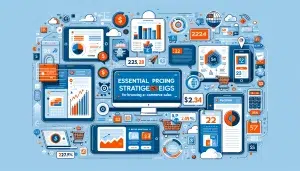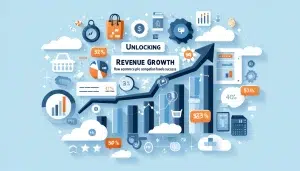Unlocking the Secrets of Product Pricing
The art of pricing products is a critical aspect of any e-Commerce enterprise. In the 2021 holiday season, nearly 75% of consumers in the United States indicated that a product’s price was a key factor in their buying decisions during the festive period. Developing and applying a robust pricing approach will captivate your online clientele, leading to heightened sales and increased return on investment (ROI).
There are numerous methods to boost your online sales and yield higher profits. In this article, we will delve into essential pricing strategies to help you grasp product pricing and stay ahead in the market. Keep reading!
Approaches to Product Pricing
Digital retailers must invest considerable effort in understanding their target audience and their needs, then pricing products accordingly. This, however, does not imply sacrificing profit margins to offer the lowest possible prices.
The goal is to strike a balance in your pricing strategy using a refined price management technique and adjusting your approach occasionally based on market conditions. In doing so, you can optimize your business operations.
Leverage Analytics to Decipher Customer Behavior
In contrast to physical stores, online retailers have the benefit of utilizing analytics software to examine vast amounts of data and extract valuable insights. These insights can be used to comprehend customer behavior and concentrate on different sectors to engage potential clients.
Whether employing social media campaigns or product promotions, you can test your merchandise and use data to gain consumer insights. This allows you to make well-informed decisions and price your items appropriately.
For instance, if you find that Monday is the most profitable day for a specific product, you can run a social media campaign on that day to maximize your earnings. It is essential to remember that consumer shopping behavior is a critical factor in optimizing your pricing strategy.
Suppose you sell women’s clothing and discover that a particular pair of jeans receives an overwhelming response on social media platforms. In that case, it indicates a high demand for that item. Consequently, you can adjust the product’s price to generate greater profits. The principle is simple: higher demand for a product allows for a price increase.
Conversely, if customers add a specific item to their carts but refrain from purchasing it, it suggests the price is excessive. In this situation, you should optimize the price tag on your online store for that product to stimulate more sales and achieve higher ROIs.
Data-driven price management initiatives have been shown to produce significant results, such as a 2%-7% increase in business margins and a 200-350% average growth in ROI over 12 months.
Thus, utilizing analytics software to monitor customer behavior on your online store is a significant advantage that most brick-and-mortar stores lack, enabling you to minimize errors and make data-driven decisions to streamline your business processes.
Enhance Your Website’s Layout
Online retailers with unappealing or challenging-to-use eCommerce websites will lose customers and generate fewer sales than those who invest in top-notch website design. Your eCommerce site’s layout is instrumental in refining your pricing strategies.
For instance, your product descriptions should include a call-to-action to entice customers and prompt them to buy the item. Ensure you display the product in a “Buy Now” or “Customer Favorite” format. Mastering these tactics allows you to optimize your sales and make informed decisions regarding your pricing strategies.
Google research reveals that customers take only 50 milliseconds to form an initial impression of your website, and this first impression can have far-reaching effects on various marketing efforts.
Experts advise incorporating a countdown timer for temporarily discounted prices to draw customers. Many online retailers employ this tactic to prompt users to act and seize the offer.
Additionally, you can display the number of remaining items in your inventory on your website to motivate visitors to buy your products before they run out. This sense of urgency can be an effective tool in encouraging sales and maximizing your profits through strategic pricing.
Scarcity Marketing and Website Design
Additionally, you can display the number of remaining items in your inventory on your website to motivate visitors to buy your products before they run out of stock. This strategy, known as scarcity marketing, creates a sense of urgency and encourages customers to make a purchase.
Lastly, ensure that your website is easy to navigate, mobile-friendly, and visually appealing. A well-designed website with clear pricing information will provide a seamless user experience and lead to higher conversions.
Implement Dynamic Pricing
Dynamic pricing is an approach that allows digital retailers to modify their product prices based on real-time demand, supply, and market trends. This strategy is particularly useful in highly competitive markets, as it enables you to stay ahead of your rivals by offering competitive prices.
For instance, if a competitor reduces the price of a specific product, you can adjust your price accordingly to maintain your market share. Alternatively, if a competitor’s product goes out of stock, you can capitalize on the situation by slightly increasing your price to maximize profits.
Dynamic pricing can be automated using advanced algorithms and software, which analyze market trends, competitor prices, and customer behavior to suggest optimal pricing adjustments.
However, it is crucial to be cautious when implementing dynamic pricing. Some customers may perceive frequent price fluctuations as unfair or manipulative, leading to a negative brand image. To avoid this, ensure that your pricing changes are reasonable and transparent.
Conclusion
Mastering product pricing is essential for digital retailers who aim to maximize profits and remain competitive in the ever-evolving eCommerce landscape. By leveraging analytics, enhancing your website layout, and implementing dynamic pricing strategies, you can optimize your pricing approach and boost your business’s success. Remember to stay informed about market trends, customer behavior, and competitor pricing tactics to ensure that your pricing strategy is effective and adaptable to the constantly changing digital retail environment.
Additional resources you may find interesting
- Pricing Strategies to Increase eCommerce Revenue by HubSpot
- B2B Ecommerce Pricing Strategies to Uplevel Your Online Store by BigCommerce
- Dynamic Pricing Algorithms, Consumer Harm, and Regulatory Response by Harvard Business School
- While Supplies Last: 8 Scarcity Marketing Tactics to Boost Conversions by Shopify
- 15 Pricing Strategies to Boost Your Sales (With Examples) by Oberlo
- PRICING STRATEGY: How To Find The Ideal Price For A Product Youtube






